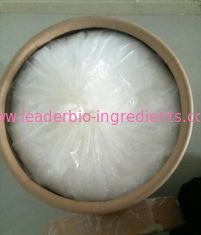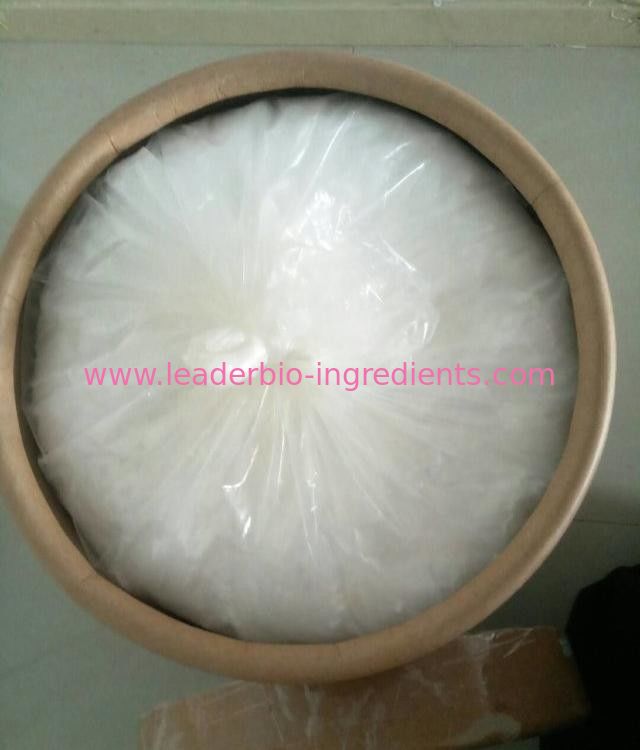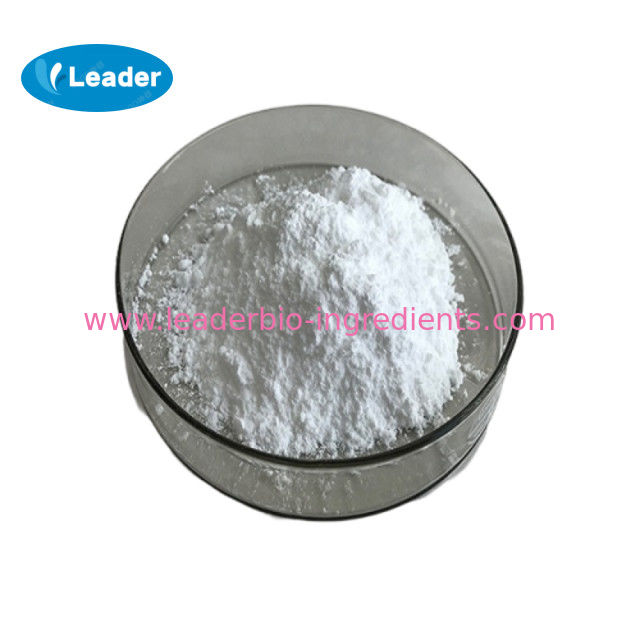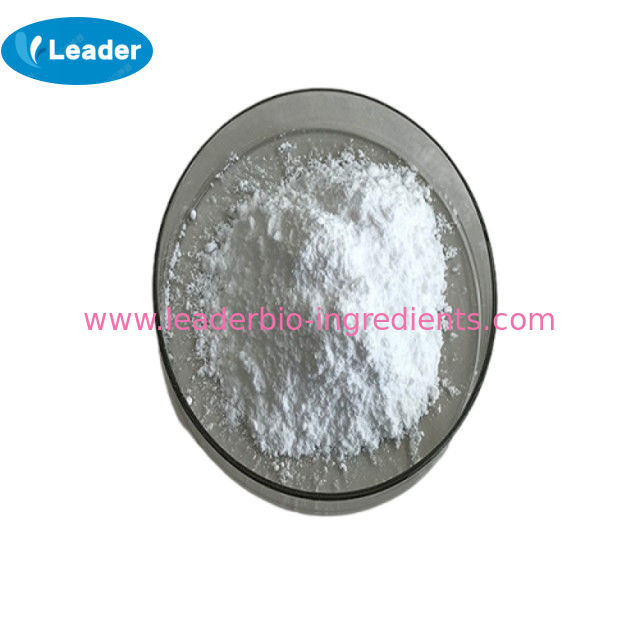
China Factory Supply Choline chloride CAS 67-48-1 Inquiry: info@leader-biogroup.com
-
Purity99.9%
-
UseChemical Raw Materials
-
OriginChina
-
Package25KG/Drum
-
ManufacturerXI'AN LEADER BIOCHEMICAL ENGINEERING CO.,LTD
-
AppearanceWhite Powder
-
Place of OriginCHINA
-
Brand Nameinfo@leader-biogroup.com
-
CertificationISO,GMP,SGS,HALA,KOSER,HACCP
-
Model NumberLD
-
Minimum Order Quantity25KG
-
PriceNegotiate Depend on order quantity
-
Packaging Details25KG/Bag
-
Delivery Time2-3 working days
-
Payment TermsWestern Union, MoneyGram, T/T, L/C
-
Supply Ability10MTS/Month
China Factory Supply Choline chloride CAS 67-48-1 Inquiry: info@leader-biogroup.com
LEADER BIOCHEMICAL GROUP
XI'AN LEADER BIOCHEMICAL ENGINEERING CO.,LTD
Inquiry: info@leader-biogroup.com
Hot Line: +86-029-68895030
+86-029-68569962
Fax : +86-029-68569961
| Product Name: | Choline chloride |
| Synonyms: | Choline Chloride pure;Choline chloride >=97.0% (AT);Ethanaminium, 2-hydroxy-N,N,N-trimethyl-, chloride (1:1);HOEtN1,1,1Cl;Cholinii chloridum;Choline chloride, 99% 1KG;Choline chloride, 99% 500GR;Choline chloride, 99% 50GR |
| CAS: | 67-48-1 |
| MF: | C5H14ClNO |
| MW: | 139.62 |
| EINECS: | 200-655-4 |
| Product Categories: | LIPOTRIL;substrate;Antioxidants;Intermediates & Fine Chemicals;Aliphatics;Amines;Quarternary ammonium salts;Ammonium Chlorides (Quaternary);Biochemistry;Quaternary Ammonium Compounds;Vitamin Related Compounds;Vitamins;Pharmaceuticals;medical;VX:15689727968 |
| Mol File: | 67-48-1.mol |
| Choline chloride Chemical Properties |
| Melting point | 302-305 °C (dec.) (lit.) |
| density | 1.0238 (rough estimate) |
| FEMA | 4500 | Choline chloride (Also Includes Choline) |
| refractive index | 1.5400 (estimate) |
| storage temp. | Sealed in dry,Room Temperature |
| solubility | H2O: 1 M, clear, colorless |
| form | Adhering Crystals |
| color | White |
| PH | 5.0-7.5 (25℃, 1M in H2O) |
| Water Solubility | soluble |
| λmax | λ: 260 nm Amax: 0.015 λ: 280 nm Amax: 0.010 |
| Sensitive | Hygroscopic |
| Merck | 14,2206 |
| JECFA Number | 2003 |
| BRN | 3563126 |
| Stability: | Stable. Incompatible with strong oxidizing agents, moisture. Store under a dry atmosphere. |
| InChIKey | SGMZJAMFUVOLNK-UHFFFAOYSA-M |
| CAS DataBase Reference | 67-48-1(CAS DataBase Reference) |
| NIST Chemistry Reference | Choline chloride(67-48-1) |
| EPA Substance Registry System | Choline chloride (67-48-1) |
| Safety Information |
| Hazard Codes | Xi |
| Risk Statements | 36/37/38 |
| Safety Statements | 26-36 |
| WGK Germany | 1 |
| RTECS | KH2975000 |
| F | 3-9 |
| TSCA | Yes |
| HS Code | 29212900 |
| Hazardous Substances Data | 67-48-1(Hazardous Substances Data) |
| Toxicity | LD50 in rats (g/kg): 0.400 i.p.; 6.64 orally (Hartung, Cornish) |
| Choline chloride Usage And Synthesis |
| B vitamins | Choline is an indispensible fundamental component in humans and animal body, often referred to as B vitamins or vitamin B4, and is a necessary low-molecule organic compound for maintaining physiological function off animal body. It can be synthesized inside animal body but still often need to be supplied to dietary and is a kind of vitamin in maximal usage amount. Inside animal cells, it can be used to adjust the in vivo metabolism and conversion of fats, preventing the fat deposition and tissue degeneration of liver and kidney, and then promote the regeneration of amino acids, enhance utilization of amino acids as well as save some part of methionine. Choline chloride is the most commonly used as well as most economical form of synthetic choline and is a water soluble vitamin, and is the component for constituting of acetylcholine, lecithin, and nerve phospholipids of biological tissue. Moreover, it can save methionine and is an important material required for livestock, poultry, and fish. Inside animal body, it can be used for adjusting in vivo metabolism and conversion of fats and can prevent the deposition in liver and related tissue degeneration. As a methyl donor, it can promote the re-formation of amino acids and improve the utilization of amino acids. It is mainly used as an additive for being mixing into the animal feed. During the exact usage process, in addition to prevent moisture deliquescence, you should also note that all kind of feeds usually take the addition of choline chloride as the last step. Because of its destruction effects on other vitamins, especially its rapid destruction on vitamin A, D, K in the presence of metal elements, multi-dimensional formulation should not include choline. Daily feed supplied with it should be used as soon as possible after the addition. Tests have showed that choline chloride is especially important for chicken poultry. Its synthetic amino acids and lecithin can be delivered to various locations inside chicken bodies, being able to prevent the fat deposition in the liver and kidney and accelerate the growth of chickens and increase egg production and hatchability. The above information is edited by the Chemicalbook of Dai Xiongfeng. |
| Content Analysis | Accurately weigh sample of about 300 mg and put it into 250 ml Erlenmeyer flask; add 50 ml of glacial acetic acid and heated on a steam bath until complete dissolving. After cooling, add 10 ml of mercury acetic acid mercury test solution (TS-137) and 2 drops of gentian violet reagent; use the acetic acid solution of 0.1 mol/L perchloric acid for titration to green endpoint. At the same time carry out a blank test and make necessary calibration. Each Ml of 0.1mol/L perchloric acid is equivalent to 13.96 mg of choline chloride (C5 H14ClNO). |
| Toxicity | ADI does not make restrictive regulations (FAO/WHO, 2001). GRAS (FDA, §182.5252, §182.8252, 2000); LD50: 9000mg/kg (rat, oral). |
| Limited use | GMP limit (FDA§182.5252.2000); |
| Chemical Properties | It is white hygroscopic crystal and is odorless with fish stench. Its melting point of 240 ℃. Its 10% aqueous solution has a pH 5-6. However, it is unstable in alkaline solution. This product is easily soluble in water and ethanol but insoluble in r, petroleum r, benzene and carbon disulfide. It has a low toxicity with LD50 (rat, oral) being 3400 mg/kg. |
| Uses | Choline chloride is an animal feed additive, classified as a water-soluble B-vitamin that increases animal growth. ChCl is added exogenously to feed stocks because it plays an essential role in fat transport, metabolism, and protects cell membrane structure. It can be supplied to tissue culture media, animal feed additive and used in clinical anti-fatty liver agent. It can be used for treating fatty liver and cirrhosis. It can also be used as the feed additive which is capable of stimulating ovaries for giving birth to more eggs and farrowing. It can also facilitate the weight gaining process of livestock, fish, etc. Choline chloride is effective in the prevention and treatment of the fat deposition and tissue degeneration in the organs of livestock and poultry. It can also promote the absorption and synthesis of amino acids. Moreover, it can enhance physical fitness and disease resistance of livestock, promote their growth and development, and improve poultry laying rate. The usage amount is 1-2 g/kg. As a kind of feed additive, choline chloride has the following physiological effects: it can prevent the accumulation of the fat in liver and the kidney and tissue degeneration; it can promote recombination of amino acids; it can improve the utilization efficiency of amino acids, especially the essential amino acid methionine in vivo. In Japan, 98% of the applied choline chloride is used as the feed additives of chickens, pigs, cattle and fish and other animal. Most of them have been processed into powder; the preparation process of 50% powder is that: first add an appropriate excipient of certain particle size into the mixer is prepared by previously adding an appropriate particle size of the excipient, and then add drop wise of aqueous solution of choline chloride, after mixing, drying to derive it. Some powder products are also blended with vitamins, minerals, and drugs. Choline chloride is the vitamin B-class drug which can be used for the treatment of hepatitis, liver function degradation, early cirrhosis, and pernicious anemia. |
| Production method | (1) Continuous method for preparation of choline chloride solution: continuously send the trim hydrochloride and a certain amount of ethylene oxide separately through pump into the reactor; the reactants had a residence time at the reactor of 1-1.5h; the reaction was carried out under stirring and has its resulting product being continuously withdrawn so that the liquid level within the reactor remained stable. The withdrawn choline chloride extraction crude product entered into the stripper to obtain 60-80% choline chloride liquid product from the bottom. (2) Trim hydrochloride was reacted with ethylene oxide, and then added with an organic acid for neutralization and further concentration to obtain the choline chloride (3) Chloro-ethanol was reacted with trim to generate choline chloride. (3)Ethylene oxide method. It can be made from the reaction between ethylene oxide and trim. Add the trim ethanol solution into the reactor, send through ethylene oxide at about 30 ℃ and stirring reaction of 4 hour and further obtain it through neutralization with hydrochloric acid (control PH at 6.5-7.0). The yield of the crude product can be as high as 98%. The crude product can further be subject to activated carbon decolorizing and vacuum concentration to obtain 70% aqueous solution. The aqueous solution was added with ground corn cobs, rice hull flour, wheat bran or diatomaceous earth and some other kinds of excipients and can give 50% of the powder. (4) Chlorohydrin method. Use chlorohydrin to substitute ethylene oxide and hydrochloric acid; have it reacted with trim in the presence of a small amount of ethylene oxide or alkaline substance; First add 100 parts of chlorohydrin into the reaction vessel, further add 130 parts of trim from the liquid surface, while supplying 1.7 parts of ethylene oxide to trigger the reaction. After the addition, stir at 32-38 ℃ for 4h with the yield being 84% (calculated from chlorohydrin). For example, if catalyzed with an alkaline substance (such as quaternary ammonium salts), the one-way conversion rate can reach over 97%. Trim methanol solution and chlorohydrin is subject to heating reaction, concentration under reduced pressure, and re-crystallization to generate it. |
| Chemical Properties | White crystalline powder |
| Uses | choleretic, lipotropic, hepatoprotectant |
| Uses | Choline chloride helps in providing nourishment for pig feed and poultry feed. It acts as a food flavor enhancer. It is used as a precursor of acetylcholine and is a methyl donor in various metabolic processes and in lipid metabolism. |
| Uses | Choline chloride has been used:
|
| Definition | ChEBI: Choline chloride is a quaternary ammonium salt with choline cation and chloride anion. It has a role as an animal growth promotant. It is a chloride salt and a quaternary ammonium salt. It contains a choline. |
| General Description | Choline chloride carbamate is nonspecific inits action on muscarinic receptor subtypes. The pharmacologicalactivity of carbachol is similar to that of ACh. It isan ester of choline and thus possesses both muscarinic andnicotinic properties by cholinergic receptor stimulation. Itcan also act indirectly by promoting release of ACh and byits weak anticholinesterase activity. |
| General Description | White crystals. Practically neutral aqueous solution. |
| Air & Water Reactions | Deliquescent. Very soluble in water. |
| Reactivity Profile | An acidic organic salt. Materials in this group are generally soluble in water. The resulting solutions contain moderate concentrations of hydrogen ions and have pH's of less than 7.0. They react as acids to neutralize bases. These neutralizations generate heat, but less or far less than is generated by neutralization of inorganic acids, inorganic oxoacids, and carboxylic acid. They usually do not react as either oxidizing agents or reducing agents but such behavior is not impossible. Many of these compounds catalyze organic reactions. |
| Fire Hazard | Choline chloride is relatively nonflammable. |
| Biochem/physiol Actions | The enzymatic activities of butyrylcholinesterase (BChE) and paraoxonase 1 (PON1), two serum enzymes synthesized by the liver and related with inflammation, were decreased in a sepsis animal model injected with LPS. Choline chloride administered intravenously at 20 mg/kg body weight prevents the LPS-mediated decreases in the activities of these two enzymes . |
| Safety Profile | Poison by intraperitoneal and intravenous routes. Moderately toxic experimentally by ingestion and subcutaneous routes. Mutation data reported. A lipotropic agent which induces the reduction in fats contained in the liver. When heated to decomposition it emits toxic fumes of Cl-, SOx and NOx. See also CHOLINE. |


